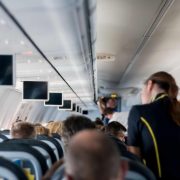Carry-on baggage
Carry-on baggage – an unpopular perspective, but worthy of discussion. One way to expedite emergency evacuations would be to promote passengers to put their valuables in small carry-on baggage kept at their feet. Don’t react, read.
As a preface to this perspective relating to carry-on baggage taken by passengers during aircraft evacuations, I am not in full support of this discussion point. However, I acknowledge the changes in the daily lives of society due to the advancement of technology and how those items may affect our priorities, regardless of circumstance. I write this to get all of us involved in passenger safety to consider the potential need to accept changes in society, the behavior of the traveling public, and mitigate the issue as much as possible.
This discussion is not my view of the right way to address passengers evacuating from an airplane during an emergency. Even further, this discussion has no relation, connection, or opinion with my employer. All I am doing is trying to find a possible solution to a known problem that no regulation or command from a flight attendant will affect – the human element. There are those that will do what they want to do, regardless of what law, regulation, policy, or command says. Especially when we consider a person being asked or directed to leave behind a bag that potentially is worth thousands of dollars and contains invaluable or highly important content for work, or about family and friends, the passenger’s thoughts are, “yeah right, I’m not leaving my stuff behind!” We all know the optimum speed of evacuation occurs when passengers leave everything behind and get out of the plane. Unfortunately, from the videos we’ve all seen on YouTube, we know this doesn’t occur.
Here are a few articles about the Aeroflot plane crash in 2019 where passengers are seen leaving the plane with their carry-on baggage. Half of the passengers died inside the plane and it’s debatable how many died because of delaying others from getting out due to retrieving their luggage.
New York Times: Why do you grab your bag when running off a burning plane?
New York Post: Passengers tried to save their bags before Russian plane burst into flames.
News.com.au: One of the greatest dilemmas facing airlines: Russian Aeroflot crash pictures expose deadly trend.
Video: How Russians were saving their carry-on baggage from a burning plane.
Video: Crash and evacuation of Aeroflot – Moscow Airport.
Video: Inside the cabin of the Aeroflot plane, passengers screaming in fear to get out. This recording is absolutely tragic, knowing 41 people died in the aircraft fire with passengers causing their own evacuation delay, wanting to retrieve their carry-on baggage. Those actions are likely a contributing factor that contributed to the deaths of some passengers.
It would be reasonable to say that all airlines around the world have the same objectives, to fly passengers to their destination safely and be prepared for emergency events, including the need to evacuate the aircraft should the situation arise. For decades, airlines have been teaching their flight attendants to shout commands during an evacuation, and included in those commands is “leave everything! Come this way!” or something very similar. The primary point is flight attendants instruct passengers to leave everything, meaning leave their carry-on baggage behind and get out of the plane. Evacuation demonstrations are/were performed with evacuation test participants evacuating the plane without anything in their hands. Everyone in Inflight operations understands the 90 seconds requirement. All passengers are expected to get out of the plane in 90 seconds or less. But let’s do an evaluation of then, decades ago, versus now with our lives highly immersed in expensive technological devices.
Airlines have lost the passengers
As mentioned in my passenger safety briefings article, airlines and flight attendants have unfortunately lost the attention of the very customers they serve and do their best to protect during an emergency. What changed over the years? Prior to portable electronic devices being invented and brought on planes, all passengers had in their carry-on baggage might be some clothes, some snacks to consume during flight, some magazines or books to read, and maybe a Walkman with a few cassettes or CDs. Objects carried in the passenger’s carry-on baggage were of little value and easily replaceable. Now, if we were to open any passenger’s carry-on baggage or backpack, it may contain items of value from as low as $500.00 to thousands of dollars worth of electronics, including smartphones, tablets, laptops, and MacBook computers. Then there are expensive headphones, data storage devices with software that’s of high value, plus intellectual property or their personal photos, documents, and almost anything digital of high value within that bag. Now, everyone’s personal or work life is in their carry-on baggage, and in their mind, they can’t afford to lose it.
I’m not going to leave my valuable things behind, especially if the plane is on fire!
The value and importance of that passenger’s carry-on bag is now very, very high due to the high value of electronics within that bag. Passengers would most likely not think twice about leaving behind their clothes, food, and reading material in their carry-on baggage during an airplane emergency evacuation. But we lose passenger willingness to listen to flight attendants’ commands to “leave everything!” when the passenger considers their portable electronic devices in their carry-on baggage. This creates a potentially serious hazardous condition during aircraft evacuations as no one is willing to just get out of the plane. Their valuables now mean too much to them and everything must go with them at the same time. If the plane is on fire, passengers know if they leave their baggage behind, consider it gone. This is a negative mindset that has high potential to contribute to passenger fatalities during an evacuation.
We’ve all seen videos of aircraft evacuations showing many passengers exiting the plane holding onto their carry-on baggage going down the slide, or their bag is in tow as they get away from the plane. To us aviation safety professionals, this is incredibly frustrating to watch because we know the fastest way to get everyone out of the plane is to leave everything behind and get out! Yet we also now know that times have changed and the value of the content within a person’s carry-on baggage has gone up astronomically.
How much is in that bag?
Even for me, to a certain extent, losing this laptop for any reason would create significant hardship on me as it contains so much of my life in it. I bring my laptop, cellphones, Bluetooth headset, wired earbuds, and thumb drives with me. At a quick guess, I’d estimate my bag contains easily $3,000.00 worth of electronics, and that doesn’t even count the software installed and time spent creating various things within the laptop. Consider that’s just me, then, factor that into all passengers on that plane. Everyone has a lot to lose. So, what to do? There is a potential solution, not the ideal one, but it would help mitigate some of the potential evacuation time lost when passengers go for their belongings. Somehow get the word out to encourage passengers to bring a small carry-on bag (i.e. backpack) that can fit under the seat in front of them and put in it all items of high value. Not only would it be more convenient for the passenger during the flight to have their items right there, but should an emergency arise, the backpack is already at their feet. Just grab it as they get up and go to the exit. The delay caused by each person stopping to open the overhead bin to retrieve their luggage would be mitigated. With a backpack, it becomes reach down, grab and go.
Going against long-established safety standards
Encouraging passengers to put all valuables into a small carry-on bag at their feet, optimally a backpack, goes against everything we have been taught and goes against the test results of full-scale emergency evacuation demonstrations. To the best of my knowledge, there hasn’t been a full-scale evacuation test with passengers carrying a backpack or small bag while they evacuate a plane. It’s not in the best interest of safety to do this, but what other viable solution is there? Most aviation safety professionals’ immediate response would be to ask people, “if your plane was on fire and you needed to get out, which do you value more, your bag or your life?” When it’s just a bag or one’s life, a person’s life would clearly win. But it’s not just the bag, it’s the items of value contained within the bag that modifies one’s priorities.
I remember as a young kid being told, “women’s lives are in their pocketbook.” I didn’t fully understand what that really meant until I got older and learned about the things some women may carry in their pocketbooks. Generally, often men had only a wallet and keys in their pockets. Fast forward to the present. With all the technology many people purchase and bring with them on flights, everyone’s bag has become highly valuable, and few are willing to risk not getting that bag back, even if it means risking their own life, or worse, someone else’s life. Think for a moment… Not just are we going up against high monetary, business, and sentimental value items, but with some people, we’re also up against doses of their narcissistic behavior. It’s all about them, they don’t care about others or what will happen to others if they are slow to get out of the plane. “As long as I am OK, that’s all that matters. Plus, I can post this on Instagram or TikTok for the likes and comments!” We see it in the videos and “challenges” out there. We can’t change passenger behavior, all we can do now is mitigate the risks.
I honestly don’t think any CAA would ever promote the idea of passengers putting their most valuable items in small carry-on baggage and keeping it at their feet for taxi, takeoff, and landing. The CAAs would most likely promote the highest level of safety, which would be to recommend airlines continue to train flight attendants to use commands that include, “leave everything! Come this way!” I do think for the most part that we are past the point of no return on getting passengers to ever leave everything behind. There will be some safety conscientious passengers that follow crewmember instructions. Occasionally, we see them in evacuation videos or photos and get excited to see that someone actually listened to the flight attendants! See 4th media item of passenger running away from the plane empty-handed. Unfortunately, such highly desired responsiveness from a passenger seems to be the outlier than the norm now.
During an emergency evacuation, passengers reaching for their larger carry-on baggage stored in the overhead bin causes notable delay. The delay comes not just from the time taken to grab the bags, but the larger carry-on bags also cause potential interference when passengers head to the exits as the bag may hit or get caught on objects in the aisle within the cabin while trying to evacuate. A small bag, perhaps a backpack with everything at their feet would allow passengers to be expeditious getting to their exit as it would contain everything of importance right there. There would be minimal delay to get passengers moving and it would effectively mitigate that issue to the lowest possible present level. The best is for passengers to leave everything behind, but those days of passenger compliance with those instructions are gone. Airlines can hardly get passengers to stop listening to music or looking at their phones for 4 minutes to watch a safety demonstration about the aircraft they are on.
Airlines and CAAs themselves would not be able to promote this, as when an accident or incident occurs and people go for their carry-on baggage and someone doesn’t get out, that would expose the airline and CAA to potential culpability for the injury or death of that passenger. It would have to be one of those things that passengers somehow become aware of and do on their own, unless airlines can find a way to convince passengers to put their valuables in a small bag kept at their feet without providing a safety-related reason. Under the guise of passenger convenience and keeping their valuables safe may be a possible ruse.
I know this method of mitigating evacuation delay goes against everything inflight safety departments have been teaching for decades and it’s unlikely any CAA would buy into it. Yet for discussion, what do you think? Enter your comments below!
To ensure everyone understands my perspective, I’m repeating this.
This discussion is not my view, not my position on the right way to address passengers evacuating from an airplane during an emergency. Even further, this discussion has no relation, connection, or opinion with my employer. All I am doing is trying to find a possible solution to a known problem that no regulation or command from a flight attendant is going to affect – the human element. There are those that will do what they want to do, regardless of what law, regulation, policy, or command says. Especially when we consider a person being asked or directed to leave behind a bag that potentially is worth thousands of dollars and contains invaluable or highly important content for work, or about family and friends. We all know the optimum speed of evacuation occurs when passengers leave everything behind and get out of the plane. This is just for rational discussion.
Additional reading
NTSB: Emergency evacuation of commercial airplanes (168 pages)










Leave a Reply
Want to join the discussion?Feel free to contribute!